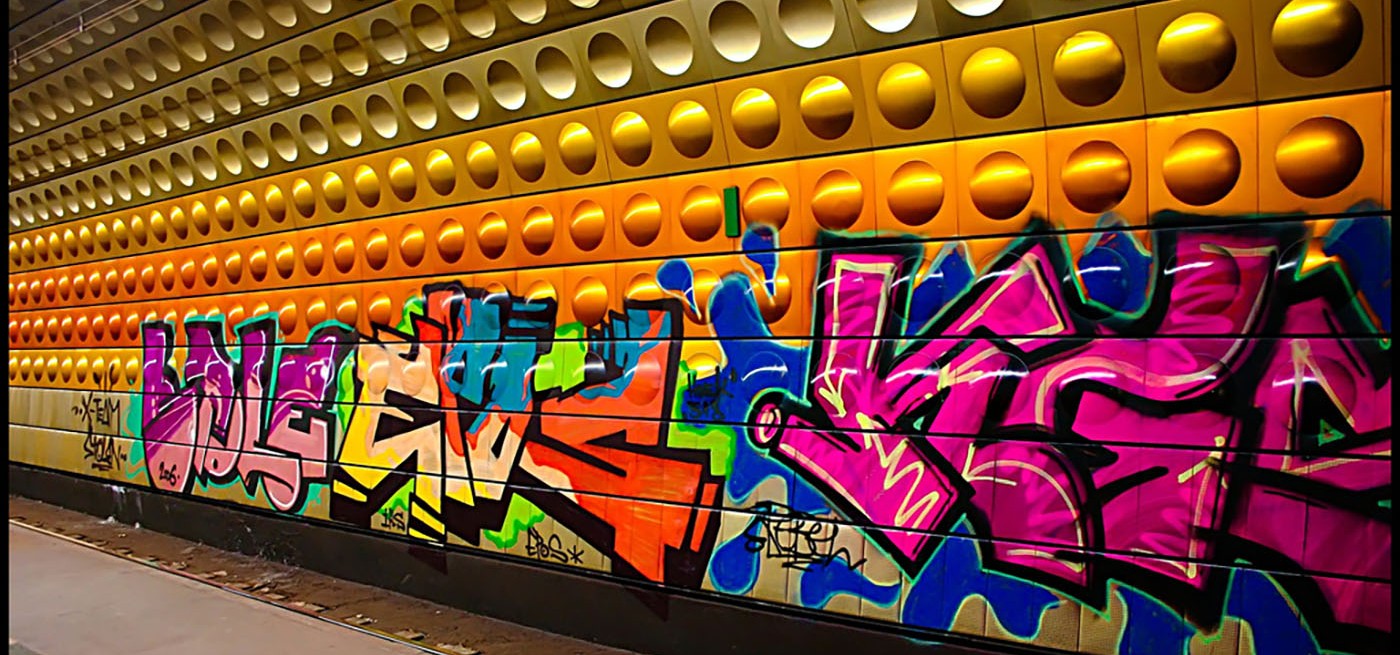Shanghai International Studies University (SISU) – July 10, 2015
Czech Debate Good Versus Bad Graffiti
By Yang Jingqian
PRAGUE — Wearing jeans and a t-shirt, Pavel, a graffiti designer in Prague, is surrounded by hundreds of spray bottles on shelves inside the Grafficon graffiti shop while he chats with two other people.
“If someone hits a girl or a guy with a car, he will be put in jail for two or three years, but if someone stays in jail for one and a half year because of graffiti, it’s ridiculous,” said Pavel.
Pavel started his graffiti career in 1992 as an amateur, but since he came to Prague and met some artists from Germany, he learned more and more and slowly gained his reputation among other artists.
“I was once held on probation for one and a half years, but I didn’t go to jail. Now I do graffiti designing and contact management system.”
According to the Czech Criminal Code, graffiti artists risk up to six years in prison for damaging and defacing public property and utilities.
“If someone draws on the Charles Bridge, it’s completely bad because it’s really old. You have to know which location is okay,” said Pavel.
The former mayor Miroslav Škaloud of Prague’s 5th district thinks that graffiti is like somebody saying he wants to express himself by hurting or damaging another person.
“These sprayers are painting on walls that belong to somebody. Graffiti writers say those walls are gray. But they could just as well say my car or my coat is too gray and dull and they want to put some color on it. No, this is definitely breaking the law and has to be punished”, said Miroslav.
In 2014, an unknown offender painted white the Lennon Wall in Prague, a symbol of protest against the Communist Party in the 1980s, and painted a single sentence, “Wall Is Over,” as a means of showing disagreement with graffiti in Prague.
According to Karolina Stehlikova, university student in Prague, she thinks that graffiti is almost everywhere. “I sometimes appreciate them when I walk if they really have artistic values. If they are just some tags, that’s vandalism. And if graffiti is on my house, I don’t like it at all.”
In Prague, on a street near Charles Bridge, the most famous sightseeing spot, two long walls are legal for graffiti writers to use.
In Berlin, artists from around the world were invited to come and each painted a section on one of the last fragments of the Berlin wall named “The East Side Gallery”, now the longest semi-preserved stretch of the Wall.
But for other places, most of them are illegal. In Berlin, about 15 people are arrested per week, with fines ranging from 100 euros to several thousand euros.
In European countries like France, Britain, Switzerland and Denmark, there are approved areas like underpasses and car parks for graffiti artists to show their works, otherwise the artists take the risk of being arrested.
Graffiti art started in Prague from the John Lennon wall for political reasons after Lennon’s death in 1980 because the regime thought that western music would inspire people to revolt against the government. At that time, although the government painted it white, new graffiti soon reappeared on the wall.
In 1988, youngsters’ graffiti on the wall even led to a clash between hundreds of students and security police on the nearby Charles Bridge.
But for Pavel, he doesn’t have any political intention of creation. “People just express their opinions with some color on the wall. It has nothing to do with politics. It’s just like some freedom speech or feelings,’’ he says.
Karolina thinks that nowadays politics has less impact. “Our generation isn’t like that of our parents. We were born after the dissolution of Czechoslovakia, so protesting against the government and political issues isn’t the trend,” she says. “I care more about things that happen just around me.”
“Now, Lennon is more of a symbol of love and peace,” she adds.
According to Pavel, there are fewer graffiti artists now. “There aren’t so many graffiti shops in Prague, but they are not only the point of selling for the cans but also a meeting and cultural point to share the experience.”
“Maybe one way to expand the street art scene in Prague is to bring in more festivals,” he adds.
 Education
Education